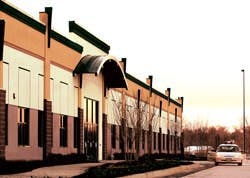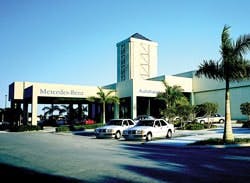Real Estate According to Wal-Mart
Wal-Mart is known worldwide as a major retailer, offering an endless supply of merchandise to the more than 138 million customers that visit its stores each week. However, Wal-Mart’s business involves more than just kitchen appliances, apparel, and electronics - it also involves real estate. A division of Wal-Mart Stores Inc., its real estate arm - Wal-Mart Realty, based in Bentonville, AR - concentrates on the disposition (through sale, lease, and/or sublease) and management of soon-to-be vacated or vacant Wal-Mart and SAM’S CLUB facilities. In simple terms, Wal-Mart Realty deals with excess space, finding new uses for former Wal-Mart stores.
The scene typically unfolds like this: A traditional Wal-Mart discount store or SAM’S CLUB achieves success in a community, and customer demand outgrows the current building. As a result, the decision is sometimes made to vacate the discount store and place a Wal-Mart Supercenter (a larger version of the discount store, offering groceries and more space) in the neighborhood. Because the building offers community value and a viable location, and because of the perceived negative effects of a vacant building (in addition to the amount of money that was being spent on the maintenance of these unused stores), the organization has made it a priority to repurpose its unoccupied buildings, committing to keep its former properties in productive use.
By vertically integrating this major portion of its real estate operations, Wal-Mart Realty’s unique take on surplus allows the organization to control its environment, costs, and power in the marketplace - and to squeeze added revenue from its real estate deals. With prime locations, versatile infrastructures, and ample parking lots, empty Wal-Mart stores can (and have) become almost anything. Buildings that once held shelves of products and rows of cash registers now house manufacturing centers, communications complexes, technical colleges, call centers, car dealerships, banks, medical centers, and other retail stores. “We’ve got a good product and a proven retail site, we maintain our properties well for our customers, we’ve got high visibility and established traffic patterns: Our infrastructure is already there, and all the improvements are in place. We’ll do any deal that makes sense,” says Scott Greear, director of building development at Wal-Mart Realty.
Back in the early 1990s, Wal-Mart decided that the Supercenter concept was a viable one. “However, we realized that putting a Supercenter into a market resulted in a relocation of our discount store. We had relocated stores prior to that, but as we saw the [need for] Supercenters to grow, we realized that we were going to be relocating a lot of stores. We had done some things to market space in the past, but we realized that we needed to take this to a whole different level,” says Tony Fuller, senior vice president, Wal-Mart Realty. At the same time that the Supercenter concept was coming into play, Wal-Mart was quickly becoming interested in obtaining ownership vs. tenancy when it came to its real estate. “As we were growing our new-store program, we became a company that wanted to own the real estate, and we weren’t as involved in lease arrangements. So, the real estate component became more significant for us as a company,” explains Fuller.
Knowing that they needed a team devoted solely to real estate development, a small group of Wal-Mart professionals began to study other real estate development companies. “We wanted to see how they did it - what we could do within Wal-Mart to put together a structure that would allow us to run our real estate portfolio like a company,” says Fuller. Visiting U.S. organizations to uncover best practices, the group put together a blueprint for creating a real estate organization. “We wanted to put something together that would allow us to address the issue of redeveloping these stores. That was the beginning of the structure. We weren’t in it very long before we realized that the key was making sure we were working with the communities, and matching what we had with what they needed. I remember sitting in a real estate developer’s office, hearing the way they would measure demographics in the market. They could tell if a community was under-represented in certain categories, and that’s how they would focus their marketing. It became apparent very early on that we’d have to match that local need.”
In 1995, Wal-Mart began to form the division that would allow it to function as a real estate development company. Mission No. 1 was to make sure the real estate team had the talent and people in place to be successful. Bringing in economic development and “alternative-use” experts, the division came to life. “Once we started down the road, we realized very quickly that, to be competitive in these types of deals, you had to be able to build out space and offer some sort of tenant improvement,” says Fuller. As a result, they put together a construction department (construction managers, estimators, designers, etc.) to offer this service to its customers.
Shortly thereafter, Wal-Mart Realty also added marketing to its growing team. “We really believe that to position ourselves to grow as a company, we needed to be unique. We had to be very aggressive, and we had to be really good at marketing excess real estate. Amazingly, we put together an organization that looks a lot like those we studied. Other than those real estate development companies we visited, we didn’t have a blueprint; there wasn’t any other retailer that was taking this course of action,” Fuller points out.
The Wal-Mart Realty division now includes 2,500 accountants, architects, asset managers, real estate professionals, attorneys, maintenance professionals, engineers, financial analysts, HVAC and refrigeration technicians, store planners, etc. The team can handle the purchase or lease of vacant buildings from start to finish, working with future tenants to create a personalized facility.
The division’s portfolio of vacant stores and unoccupied square footage is on the decline, despite Wal-Mart’s continued expansion. During the past 4 years, the division has returned more than 50 million square feet of space to productive use. It recently set an internal record, leasing/selling more than 20 million square feet of space in the span of a year. And, its goals are set even higher this year. Wal-Mart Realty is selling and re-leasing its former stores faster than ever - usually before Wal-Mart even vacates the premises.
Wondering how they do it? The division has taken the time to define and map out philosophies that work.
Step 1: Once it’s confirmed that a Wal-Mart discount store or a SAM’S CLUB will be vacated, the team conducts an evaluation of the existing building. An assessment is made of the area’s demographics and market potential, and a property appraisal is completed. The real estate team then puts together a complete portfolio for the facility and lists it on its website. “As soon as a new store has been approved and we know that we’re going to be getting that store to market, we’ve got a team that’s already looked at the building and appraised it for the value that we think we should get for it (if we lease it, what we should sublease it for; if we own it, what we should be able to sell it for). That helps our dealmakers get ahead of the game. They understand who we should be focusing our attention on as far as our marketing efforts,” says Greear.
Step 2: Local economic development professionals and other public officials in the area are made aware of the available property, and their guidance and assistance is sought in regards to its best re-use. The team also inquires about possible local business or government uses as well. “We have a group of people internally - our real estate managers - that work very closely with the communities and both local and national real estate brokerage companies to help us find the right use for that particular community,” explains Greear. “We have one individual who contacts these cities very early on, even before we’ve relocated the store, and tries to work with them to understand what’s missing. What does that city think it needs that’s not there yet?”
Step 3: An e-mail is sent to over 2,400 real estate professionals, and marketing is stepped up through national advertising and local/regional brokers. Wal-Mart Realty shares information regarding available buildings, area demographics, etc. with various associations and organizations, viewing these forums as an opportunity to network with other retailers, developers, property owners, and investors.
Step 4: Once a new tenant decides to move in, Wal-Mart engages its in-house construction staff (architects, engineers, designers, and construction managers) to subdivide/renovate these spaces. The team takes the existing building’s infrastructure and modifies it for an ideal fit. Tenants can purchase or lease space, with utilities, parking, and zoning already established. The organization can even subdivide the space inside a building into different sections for different tenants, splitting utilities and modifying HVAC, sprinkler, and electrical set-ups.
“The decision was made a long time ago to start marketing early,” says Greear. “We market a building for a new use as far out as 2 years before we actually relocate. We aren’t afraid to get out in front and show people what we have. Marketing is more than putting a sign on a building.” Since Day One, Wal-Mart Realty has believed that, to grow as a company, it needed to be unique, aggressive, and good at marketing excess real estate.
To promote its offerings, the organization uses multiple outlets. Looking at what their potential purchasers are reading, the organization advertises in relevant publications. Team members attend industry and trade shows, anxious to meet possible tenants. Working with brokers in the communities where vacant properties are located, Wal-Mart Realty also spreads the word locally. “We’re always looking for new ways to attract purchasers, and we’ll continue to do so every day. We don’t just sit back and wait for the customers to find us. It’s important that we’re out there searching for those customers. That takes thinking about it differently every day and every week. We can’t just keep doing the same thing over and over again. We have to keep looking for new ideas and new ways to reach people,” says Carole Baker, Wal-Mart Realty’s director of land development. Special emphasis is placed on the division’s website, where a complete portfolio of every available property is listed.
Often dubbed an “aggressive” marketer, Wal-Mart Realty will find a solution for almost any issue, sometimes even paying to demolish the property or refurbish it for a tenant. “I would boil ‘aggressive marketing’ down to people with a passion for what they do. That keeps us out there constantly looking for a new concept,” says Baker. The division frequently re-evaluates its marketing efforts, modifying and working to understand the results of its attempts.
“We like to say that our people make the difference.”
It’s clear that one thing setting Wal-Mart Realty apart from its competition - and contributing to its record-setting performance - is its philosophy of involving employees in the real estate process at many different levels. “We needed a whole lot more than the boxes on an org chart - we needed an organization full of people who really had a passion for doing this work, and a desire and a capacity to grow,” says Fuller. “You get it done through good people; you’ve got to invest in your people.”
The word “team” can be used to describe the work being done at Wal-Mart Realty in every aspect. “We have a group of professionals here that really excels at this type of real estate; it’s a tough thing to do. You’re trying to convert something that was built to be a retail store and turn it into something else. You’ve got to be creative. We like to say that our people make the difference,” explains Greear.
Baker credits her team as well. “We’re always looking for ways to attract purchasers. We do that in a lot of ways. We have a group of dedicated people who come in and work very hard every day to look for new uses. I just can’t emphasize enough the importance of the people of Wal-Mart Realty, the team that we have, and the successes that we see.”
Fuller describes the future as a period of continued growth for the division: “If you look at the organization we’ve built, the people we have recruited and grown, and the people that really make this organization work - the fact of the matter is, the capacity within our group is such that they’re up to whatever challenges the future may hold.” And with that kind of confidence, Wal-Mart Realty is certain it will be able to handle whatever the future may hold - whether it involves new ways of marketing available properties, acquiring more square footage to sell and lease, or becoming even more enmeshed in the commercial real estate industry.
The organization actively involves economic development and local government officials when finding new tenants for its existing buildings. Finding the right re-use for each building isn’t easy (especially not from Bentonville, AR), so the division relies on its relationships with local brokers. “The challenge is to make sure we put the right use - the right fit - into that building. What we don’t want to do is just stick the first possible use - or even necessarily the highest-rent payer - in the building. We want to put in the right fit for that community,” explains Greear.
“We really try to make it a point to work closely with the brokerage community,” says Greear. “We’ve developed a great relationship with brokers across the country who are really good at what they do. These aren’t Wal-Mart associates - these are people that do this for a variety of clients. ” Wal-Mart Realty has approximately 75 percent of its properties listed with local/regional brokers, and is convinced that embracing the brokerage community makes a big difference in the organization’s achievement.
“One of the things that we had to gravitate away from was the fact that, as we began the organization, we were very much Bentonville-centric. We weren’t quick to involve local brokers ... to bring local expertise into it,” explains Fuller. “In those early days, we may have had a local broker on less than 25 percent of our properties. We had to learn to move to that, which put us closer to the market.”
Wal-Mart Realty intermingles with the New York City-based Intl. Council of Shopping Centers and the Washington, D.C.-based Urban Land Institute. To help identify non-retail uses for its previously occupied facilities, the division markets properties to the Intl. Economic Development Council, the Southern Economic Development Council, local/state economic development agencies, CoreNet Global, the Intl. Association of Corporate Real Estate Executives, and local utility providers. “We put ourselves out there; we get involved with all sorts of organizations. We want to be visible in the real estate community,” says Fuller.
With these four viewpoints (maintaining an organized approach, emphasizing aggressive marketing, creating a team environment, and staying visible in the real estate community) at the core of every real estate transaction it completes and every building it repurposes, Wal-Mart Realty fills an essential role for Wal-Mart Stores Inc. “We’re a tremendous growth company,” emphasizes Fuller. “Wal-Mart Stores Inc. is going to do 350 projects in the United States this year - that’s almost a store a day that opens. That creates opportunities for us. And as long as we do our work well - as long as we take care of our tenants - then there are going to be good things ahead for us.”
Leah B. Garris ([email protected]) is senior associate editor at Buildings magazine.



